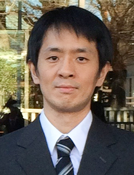2024/05/16(Thu) 10:00 -12:00 五樓第一會議室 5F, 1st Meeting Room

Title
Observation of small Fermi pockets in high-Tc cuprate superconductors
Speaker
近藤猛教授 (Institute for Solid State Physics, The University of Tokyo) Prof. Takeshi Kondo (Institute for Solid State Physics, The University of Tokyo)Abstract
The superconductivity with a high critical temperature (Tc) is generated by carrier doping to a Mott insulator in cuprates. Therefore, the understanding of the electronic properties of CuO2 planes with a low carrier concentration close to the half-filed Mott state is essential to elucidate the mechanism of the high-Tc superconductivity. The electronic phase diagram established in cuprates so far has been based on studies for single and double-layered cuprates. However, the conductive CuO2 sheets in these compounds are adjacent to dopant layers which causes a strong disorder effect as revealed by scanning tunneling spectroscopy. Hence, the intrinsic nature of the electronic state especially of a lightly doped region that is sensitive to disorder due to a weak screening effect might have yet been understood well. This circumstance might have even been a major cause hindering one from unveiling the superconducting mechanism in cuprates. This difficult situation, however, could be overcome by focusing as a research target on the inner CuO2 plane in multilayer cuprates, which avoids direct contact with dopant layers and thus can realize a clean, nearly ideal electronic state [1]. Especially note that the formation of small Fermi pockets predicted in a dropped Mott state has not been observed in the prototype single- and double-layered cuprates; instead, an arc-like Fermi surface has been observed in them. The origin of the Fermi arc and its relationship with a small Fermi pocket and large Femi surface is still under debate, and it has been one of the central topics not only in cuprate research but also in condensed matter physics.
In my presentation, I will introduce our recent ARPES studies of multi-layered cuprates Ba2Can−1CunO2n(F,O)2 [2,3]. These compounds have clean, thus ideal CuO2 planes in the inner layers, which, thus, may reveal the phase diagram inherent for cuprates that has not been unveiled so far. Most importantly, we found small Fermi surface pockets around (π/2,π/2) consistently by ARPES and quantum oscillation measurements [2]. We also find that the d-wave superconducting gap opens along the pocket, thus the superconductivity and antiferromagnetic order coexist in the same CuO2 sheet. By increasing the number of CuO2 planes per unit cell up to six, we could reduce the carrier concentration of the innermost CuO2 planes down to less than 1%. Surprisingly, we found a tiny Fermi pocket to exhibit well-defined quasiparticle peaks, lacking the polaronic feature that was expected in the prototype single- and double-layered cuprates [3]. This indicates that the slightest amount of carriers is enough to turn a Mott-insulating state into a metallic state with long-lived quasiparticles in CuO2 with the disorder removed. By tuning hole carriers, furthermore, we found an unexpected phase transition from the superconducting to metallic states. These results are distinct from the nodal liquid state with polaronic features proposed as an anomaly of the heavily underdoped cuprates, possibly indicating more intrinsic electronic states in the lightly doped cuprates.
References
[1] H. Mukuda et al., Journal of the Physical Society of Japan 81, 011008 (2012).
[2] S. Kunisada et al., Science 369, 833 (2020).
[3] K. Kurokawa et al., Nature communications 14, 4064 (2023).
CV
Language
演講語言 (Language): in English